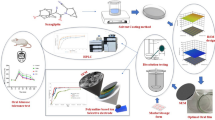Abstract
Objectives
The objective of this study was to develop a gastroretentive dosage form (GRDF) of carvedilol cocrystals that were prepared utilizing hot-melt extrusion (HME) in order to prolong its gastric residence time. GRDF was optimized using Box-Behnken Design.
Methods
The carvedilol nicotinamide cocrystals prepared in the ratio of 1:2 (drug:coformer) utilizing hot-melt extrusion (Omega10). The tablets were prepared by direct compression using cocrystals along with remaining excipients that include HPMC K4M, HPMC E50, Carbopol 934P, sodium bicarbonate, microcrystalline cellulose, talc, and magnesium stearate. Concentrations of HPMC E50, HPMC K4M, and Carbopol 934P were selected as independent factors while the gastroretentive parameters such as floating lag time (FLT), percentage of drug release in 2 h, and percentage of cumulative drug release in 12 h were selected as dependent variables in optimizing GRDF of carvedilol cocrystals. Test such as total floating time (TFT), floating lag time (FLT), swelling studies, dissolution studies, and precompression parameters such as bulk density (BD), tapped density (TD), compressibility index (CI), Hausner’s ratio (HR), and angle of repose were carried out on the optimized formulation.
Results
The optimized tablets (F2) prepared by direct compression showed FLT of 11 s after placing the tablets in 0.1 N HCl (pH 1.2) with controlled drug release for 12 h where the mechanism of drug release was found to be Non-Fickian type of diffusion (swelling, erosion, and diffusion). The in vitro drug release profile of the optimized formulation (F2) was found to be 81.4% at 12 h in comparison with a formulation containing only carvedilol (65.55% drug release at 12 h).
Conclusion
The study concluded that the cocrystals of carvedilol that were successfully prepared by HME could be used to prepare and optimize the floating tablets to achieve desired gastroretentive performance with good drug release profile for carvedilol. The results of the comparison of drug release profile between optimized formulation and formulation containing pure drug stressed the importance of preparing cocrystals. The formulation scientist in the future may adopt these strategies in developing GRDF for cocrystals of any drug.






Similar content being viewed by others
References
Sanjay AN, Manohar SD, Bhanudas SR. Pharmaceutical cocrystallization: a review. J Adv Pharm Educ Res Oct-Dec. 2014;4(4).
Kotak U, Prajapati V, Solanki H, Jani G, Jha P. Co-crystallization technique its rationale and recent progress. World J Pharm Pharm Sci. 2015;4(4):1484–508.
Yamamoto K, Tsutsumi S, Ikeda Y. Establishment of cocrystal cocktail grinding method for rational screening of pharmaceutical cocrystals. Int J Pharm. 2012;437(1):162–71.
Kalimuthu S, Yadav AV. Formulation and evaluation of carvedilol loaded eudragit E100 nanoparticles. Int J PharmTech Res. 2009;1:179–83.
Jamakandi VG. Formulation and evaluation of immediate release tablet of carvedilol using liquisolid compacts technique for solubility enhancement. Asian J Pharm. 2016;10(03).
Li S, Yu T, Tian Y, McCoy CP, Jones DS, Andrews GP. Mechanochemical synthesis of pharmaceutical cocrystal suspensions via hot melt extrusion: feasibility studies and physicochemical characterization. Mol Pharm. 2016;13(9):3054–68.
Hamed R, Awadallah A, Sunoqrot S, Tarawneh O, Nazzal S, AlBaraghthi T, et al. pH-Dependent solubility and dissolution behavior of carvedilol—case example of a weakly basic BCS class II drug. AAPS PharmSciTech. 2016;17(2):418–26.
El-Say K. Optimized gastroretentive floating carvedilol tablets: an approach for prolonged gastric residence time and enhanced absorption.
Mandal UK, Chatterjee B, Senjoti FG. Gastro-retentive drug delivery systems and their in vivo success: a recent update. Asian J Pharma Sci. 2016;11(5):575–84.
Nayak AK, Das B, Maji R. Gastroretentive hydrodynamically balanced systems of ofloxacin: in vitro evaluation. Saudi Pharma J. 2013;21(1):113–7.
Park H, Kim D. Swelling and mechanical properties of glycol chitosan/poly (vinyl alcohol) IPN-type superporous hydrogels. J Biomed Mater Res A. 2006;78(4):662–7.
Klausner EA, Lavy E, Friedman M, Hoffman A. Expandable gastroretentive dosage forms. J Control Release. 2003;90(2):143–62.
Fujimori J, Machida Y, Tanaka S, Nagai T. Effect of magnetically controlled gastric residence of sustained release tablets on bioavailability of acetaminophen. Int J Pharm. 1995;119(1):47–55.
Ichikawa M, Watanabe S, Miyake Y. A new multiple-unit oral floating dosage system. I: preparation and in vitro evaluation of floating and sustained-release characteristics. J Pharm Sci. 1991;80(11):1062–6.
Özdemir N, Ordu S, Özkan Y. Studies of floating dosage forms of furosemide: in vitro and in vivo evaluations of bilayer tablet formulations. Drug Dev Ind Pharm. 2000;26(8):857–66.
Pawar HA, Dhavale R. Development and evaluation of gastroretentive floating tablets of an antidepressant drug by thermoplastic granulation technique. Beni-Suef University J Basic Appl Sci. 2014;3(2):122–32.
The United States Pharmacopeia TNF. USP 28/NF 23. Rockville: US Pharmacopoeial Convention Inc.; 2005.
Arza RA, Gonugunta CS, Veerareddy PR. Formulation and evaluation of swellable and floating gastroretentive ciprofloxacin hydrochloride tablets. AAPS PharmSciTech. 2009;10(1):220–6.
Sharma OP, Shah MV, Parikh DC, Mehta TA. Formulation optimization of gastroretentive drug delivery system for allopurinol using experimental design. Expert O Drug Deliv. 2015;12(4):513–24.
Dash S, Murthy PN, Nath L, Chowdhury P. Kinetic modeling on drug release from controlled drug delivery systems. Acta Pol Pharm. 2010;67(3):217–3.
Acknowledgements
The author would like to thank Manipal College of Pharmaceutical Science, Manipal Academy of Higher Education for providing support.
Author information
Authors and Affiliations
Corresponding author
Ethics declarations
Conflict of Interest
The authors declare that they have no conflict of interest.
Additional information
Publisher’s Note
Springer Nature remains neutral with regard to jurisdictional claims in published maps and institutional affiliations.
Rights and permissions
About this article
Cite this article
Fernandes, G.J., Rathnanand, M. Formulation Optimization for Gastroretentive Drug Delivery System of Carvedilol Cocrystals Using Design of Experiment. J Pharm Innov 15, 455–466 (2020). https://doi.org/10.1007/s12247-019-09393-5
Published:
Issue Date:
DOI: https://doi.org/10.1007/s12247-019-09393-5




